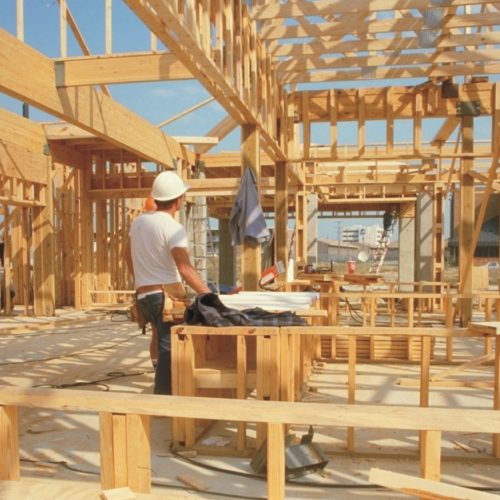Southern Yellow Pine Facts, Grades, Uses & Industry Insights: 2024 Update
For over fifty years, American International Forest Products has been trading a variety of lumber, industrial products, and other building materials for construction and manufacturing projects across the country. In this month’s blog, our lumber experts cover everything you need to know about Southern yellow pine wood, including what it’s used for, how it’s graded, and more.
Southern Yellow Pine Facts
Southern yellow pine is a blanket term used to describe a pine species whose major range is south of the Mason-Dixon line and east of the Great Plains in the United States. There are ten species of pines that are considered southern yellow pines, including the four most common species: loblolly, shortleaf, longleaf, and slash. These four species make up 90% of the southern pine timber inventory.
Southern yellow pine is considered a softwood lumber, as it comes from an evergreen tree that produces needles and cones. Like other softwoods, Southern yellow pine wood is more workable, sustainable, and affordable than hardwoods, which tend to be less flexible and slower to regrow.
Where do Southern Yellow Pines Grow?
Southern yellow pine trees grow across the South and Mid-Atlantic region of the United States, including as far south as Florida and Texas and as far north as Maryland and New Jersey.
Southern Yellow Pine Wood Uses
Southern yellow pine wood is one of the principal sources of softwood products in the United States. Not only is SYP lumber strong, stiff, and dense, but it also holds nails and other fasteners particularly well, which makes it a great choice for residential and commercial construction.
Southern yellow pine wood has a unique cellular structure, making it one of the preferred species for pressure treatment. In fact, SYP wood makes up nearly 85% of all pressure-treated wood produced in the United States. Plus, its distinct grain pattern and appealing golden color make it a great choice for anyone looking to showcase the natural beauty of pine.
Because of its competitive pricing, thriving supply, and the established market preference, Southern yellow pine wood use continues to grow. Many companies use Southern yellow pine in the manufacturing of trusses and other construction framing, modular home and deck construction, and in pallets, crating, and other packaging.
Southern Yellow Pine Lumber Grades
Southern yellow pine lumber is produced in several grades and board sizes, and different grades and sizes tend to work better for different types of projects. The grading itself happens at the mill, where the wood is visually inspected. Different grades limit certain characteristics such as knots, checks, and splits in order to determine its relative strength properties and appearance. Some of the common lumber grades for Southern yellow pine wholesalers include #1, #2, #3, #4, dense select structural, prime, machine stress rated, timber, and decking.
Understanding the Pine Industry
At AIFP, our SYP traders keep up to date on changes within the lumber industry through daily communication with Southern yellow pine sawmills, suppliers, and end users, as well as by attending industry trade shows like the Building Component Manufacturers Conference and Frame Summit.
Southern yellow pine lumber production has increased dramatically based on the need for dimensional lumber and its low-cost fiber base. In fact, between new Southern yellow pine mills and the improvements at established mills, the industry has created close to 1 billion added board feet in the southern region.
In addition to this growth, there’s been an increase in Canadian influence in the pine industry. Many of the mills in the south have been purchased by Canadian producers, likely because of the lack of fiber in Western Canada. Because of its low cost and availability, the uses for Southern yellow pine will continue to grow in the United States and beyond.
Douglas Fir Vs. Southern Yellow Pine
Deciding between Douglas Fir and Southern yellow pine lumber? While Douglas fir and SYP lumber are both softwoods with similar features, there are some differences to be aware of. Douglas fir tends to be more naturally water-resistant than pine; however, pine takes pressure treatment better than most other woods, making it a great option for outside applications. While Douglas fir is stronger than many types of pine, SYP wood actually ranks as stronger than Douglas fir lumber. That said, both Douglas fir and Southern yellow pine can both be great options for decking, flooring, framing, and more.
Where Can I Buy Southern Yellow Pine?
If you’re in the market for Southern yellow pine wood or other wholesale lumber options for an upcoming construction or manufacturing project, AIFP has got you covered. Contact us today to learn more about our building material solutions and how our knowledgeable lumber traders and Southern yellow pine wholesalers can help meet your diverse bulk lumber needs.
Need more general info about SYP lumber? Take a look at the answers to these frequently asked questions about Southern yellow pine. In the meantime, check out our lumber blog where we cover everything from the benefits of working with a wholesale lumber supplier to what you need to know about SYP plywood, Douglas fir plywood, and OSB board.
(Image Source: Southern Forest Products Association)

Jump Start Your Career
Up for the challenge? We'll give you the tools to excel. AIFP is continually growing. We recruit new traders year-round.
